Do you struggle to choose stitches or colors for your embroidery projects?
Don’t be discouraged if you do! It’s not unusual, no matter where you are in your embroidery journey. Often, it’s trial and error that will give you the answer you want: just the right stitch, or just the perfect color.
Sometimes, your choices will depend very much on the end use of your project. If you’re embroidering something that’s going to be framed on a wall, believe it or not, you have a lot more scope for stitch choice, for the materials you use, and perhaps even the colors that you choose.
If you’re embroidering something that will endure use – whether heavy or light use – you have to consider how it’s going to be used and what it’s going to go through. Will it be laundered? Will it be worn? What will it adorn? Where will it be used? What environment? How will it be stored?
These types of questions can influence your choices on stitch, thread, color, design, fabric – all the choices that you make with any embroidery project that you personally plan.
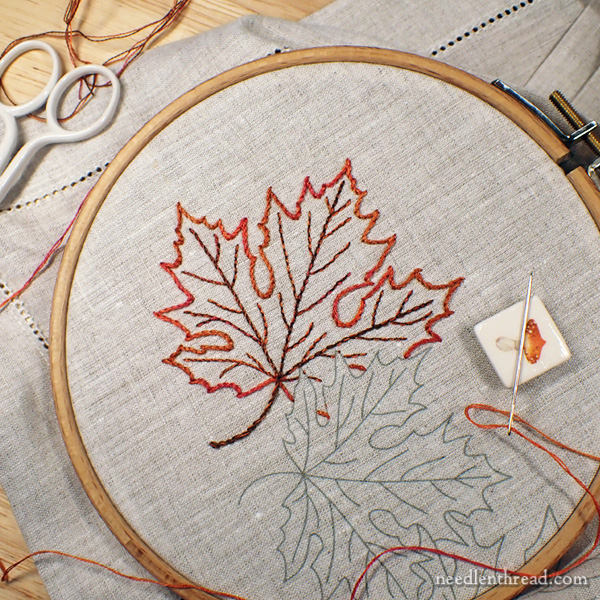
Household linens, like this pre-finished linen table runner that I introduced to you last week, are meant for use.
They’re meant to adorn something visible in your house, whether it’s a table, a cabinet top, a piece of accent furniture. They’re not meant to be tucked away for years in a drawer.
Brief Rant
In fact, if you have linens that are tucked away in a drawer and that haven’t seen the light of day for years, take them out and use them! Rotate their use throughout the year.
Don’t let them just rot away, hidden and unseen. Get the pleasure out of them that you intended when you made them or acquired them!
If nothing else, it’s better for the linens. But above that, it’ll probably make you happy, too!
Rant Over
But back to this particular linen.
It’s really meant to be a serviceable piece of decoration. I intend to use it on a table through the entire autumn.
First of all, it will make my dining room (I use that term in a very loose sense, as that room is nothing formal in my house) look a little more finished.
Secondly, it will prevent me from letting things collect on the table. Mail. The crock pot. That pair of scissors. Those books I haven’t shelved yet. The myriad items that one walks through the house with, intending to put away, but then sets down on the table while taking care of some other distraction. I’ve discovered that, if my table is “dressed,” then I don’t put random things on it. When I come home from work and the table is dressed and clear, it makes me happy.
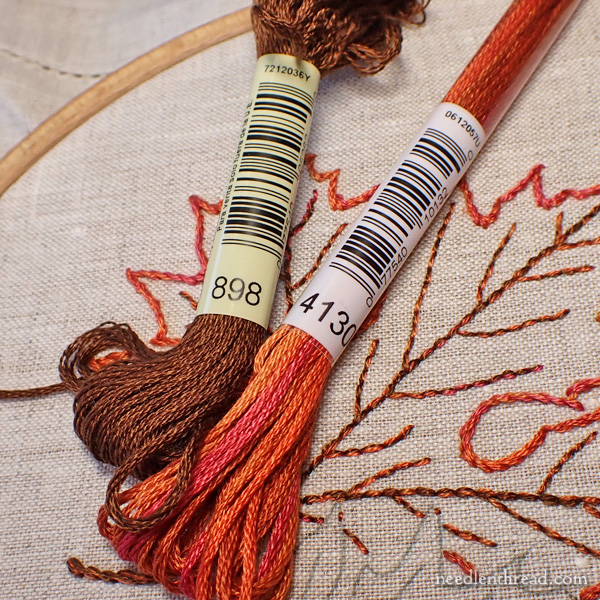
For color and thread, I’m going with DMC floss.
I knew I would play with DMC’s Variations (it’s a subtly variegated thread) on the leaves. That 4130 in the photo above provides a great range of fallish color that blends subtly through the thread.
Reverse One Thread Trick
To increase the way the colors blend – and to ensure my embroidery doesn’t suffer from any really “blocky” color changes – I did the old Reverse-One-Thread Trick.
I’m using three strands of the 4130 with the stem stitch outline. I cut a thread length from the skein, stripped out three individual strands, and then I reversed one of the strands before threading the needle.
This really helps create a very smooth and very subtle color change along a line stitched with variegated threads.
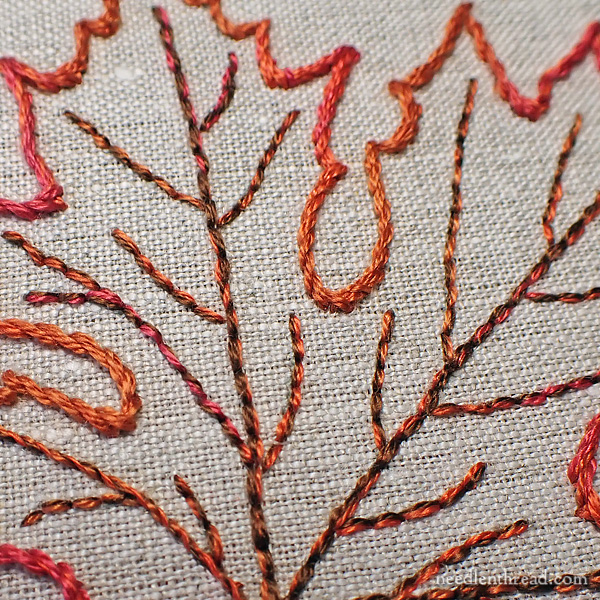
As I mentioned above, the finished linen will be used. It will likely be laundered (by hand, cool water), dried, and pressed at least once before it’s put away for the season.
I want stitches that will hold up over the years, that define the design the way I envision it. I don’t want long stitches that will be caught on things. I don’t want to use filling stitches (because I don’t want to take the time, and it’s not how I envision the finished piece, anyway – I want light color, not dense).
So I knew I would use line stitches. Which ones?
Stitch Choices
I started with stem stitch for the outline of the first leaf. It’s always a safe bet and it’s a beautiful stitch.
But I may use other stitches as I go along. If I decide to add variety to the leaves by outlining with different stitches, I’ll have to consider balance across the design. Chances are, I won’t add too much variety. On household linens like this, sometimes simplicity is the better choice.
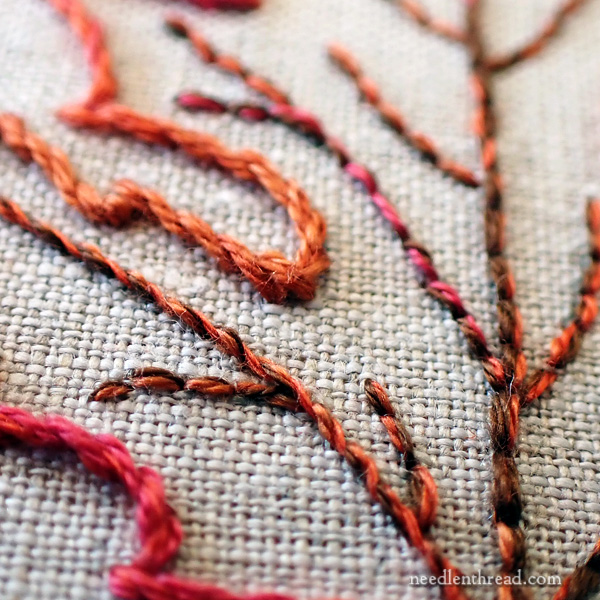
For the veins, I stuck to backstitch, which I plan to whip. For the main veins on the leaf, I used three strands for the backstitch foundation: two strands of dark brown and one strand of the variegated in the needle.
Then, I used one strand of variegated to whip the backstitch. Whipping the backstitch smooths out the backstitch and it adds just a little more color over that darker brown.
For the secondary veins, coming off the main veins of the leaf, I switched to two strands for the foundation backstitch (one brown, one variegated), and one strand to whip. This creates a much more delicate line for the smaller veins.
Even though backstitch is not a stitch I generally love and I don’t normally use it alone or without whipping it (in surface embroidery, it often comes across as a chunky, somewhat juvenile stitch), I could see leaving the veins in backstitch without whipping. The backstitch on the veins imparts a somewhat twiggy, rustic look to the leaves. I like it.
But for now, I’m whipping the backstitch. I may change this approach. We shall see.
Experimentation! Trial and error! Sometimes, this is how you make the best choices for your projects!
So, that’s where I am on this project, and those are pretty much my thought processes and reasoning as I’ve been working on it. We’ll see how things change with the next leaves. Stay tuned!
Materials and Supplies
Here’s a list of materials and supplies I’m using for this project.
Pre-Finished Linen Blank – this is a beautiful pre-finished runner made from Italian linen. You can read about them here and they are available here. (I’m out of natural at this time, but I do have white in stock.)
5″ Wooden Embroidery Hoop – bound with cotton twill. These hoops are available here, and they come packaged with cotton twill to wrap the inner ring. They are my favorite hoops, because they’re nice and smooth and they have good, sturdy, all-brass hardware. You can read about how to bind a hoop here.
Tulip Embroidery Needles – #7 embroidery needle and a tapestry needle for whipping. You can read about Tulip Needles here and you can find Tulip Needles available here.
Embroidery Scissors – small and sharp! I’m using my Golden Forge scissors that you see in the first image. You can read about them here and they are available here.
Needle Minder – I’m using one of my small bisque needle minders that I messed up on. When you make your own equipment, the rejects come in handy! You can find these (non-reject) needle minders available here. The autumn-themed and toadstool needle minders are back in stock at the moment, since we’ve just finished another small batch. (If it’s not in stock, it will not be in the choices in the drop-down menu on the product listing.) Please read the product listing carefully for choices.
DMC Threads – At this time, I don’t carry individual thread colors, and I don’t have a thread pack for this project. Use your favorite source for DMC threads. They’re widely available. If you have a locally owned needlework shop or quilt shop, it’s worth checking there.





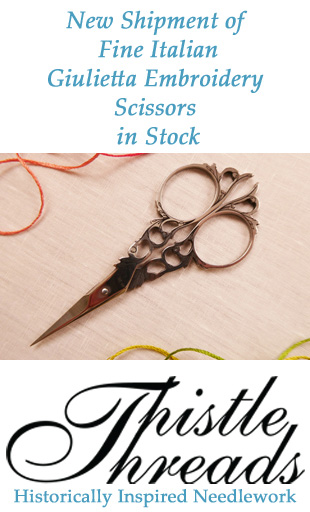
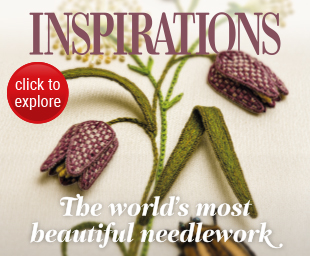

You could make it look Mountmellicky!
Oh yes indeed!! On the white runner, you could do a lovely whitework approach to the leaves! With pulled thread fillings and everything! Just keep in mind that this is a plain weave fabric, but it would still work and be beautiful.
When my husband’s aunt gave up living on her own, we got some of her furniture. One piece was a really ratty occasional square table, that had paint drips, etc. on it. I got all sorts of stuff left on it. And when he was looking for something I would tell him to check Aunt Mike’s table. One day I had enough of that messy table. I cleared everything on it. I placed a hand crocheted pink tablecloth on it. A vase with artificial magnolia blossoms. My elephant collection. Some pretty items in a resin balls, a fake Faberge egg, etc. There is no room for junk currently, so I know what you mean although I do dis notice someone has left two coins on the table.
Hi Mary,
I’m certain that the runner will look lovely.
What I’m curious about is how you finish the threads to ensure that the stiches will not unravel during laundry.
Cheers,
Lucia
Thanks for the question, Lucia! I will talk about that!
Regarding your rant…. Years ago, a lovely woman told me that she had inherited the family china, quilts, and linens. She carefully stored them away for safe keeping. Her house burned to the ground, and it was all gone. She told me, “Use the quilts. Use the linens. Have dinner on china whenever you feel like it.” A good 20 years later I worked for an estate sale company. The items that were never used, and stored away to keep safe were what ended up in a sale. Nobody had any memories attached. Contrast that to when I worked at a quilt shop and people would bring in quilts and blankets that were in tatters, begging someone to restore the only thing they can sleep under. We all work hard on these projects! We should be enjoying them.
Totally agree!! Thanks, Sarah!
I like your rant! Good reminder to us all. And you are so right—use these items, rotate them in and out.
i can’t seem to find floche. It’s not a t Joanne’s and they have a large display of DMC, but no floche or eco vita.
i can’t even find floche on their web site. There is no small specialty shop near me just the big box places. Very hard to find floche or crewel thread. I buy the colors my crewel supplies on line but would like to see and feel the texture before buying.
Sue H
Hi, Sue – I’m afraid you won’t find floche at big box stores. It’s a specialty thread and only available through small and locally owned shops. It’s definitely a specialty thread, and it doesn’t have the same wide following as the stranded cotton. I don’t think DMC is selling the Eco Vita through the large chain stores, either.
hi Mary. do you intend to restock the natural color table runners in the shop?
Sue
H.
Hi, Sue, I will eventually, but not until I have an order quantity that will make it worth importing them. They are not likely to be restocked before the end of this year, but if I can restock them, I will.